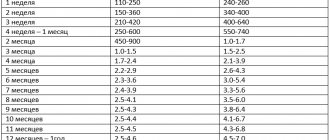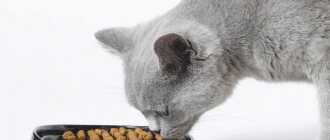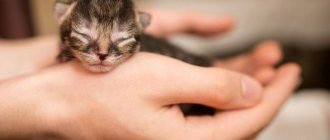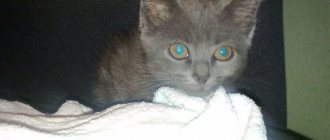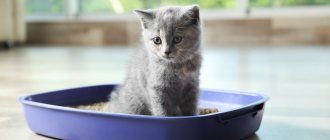British kitten weight table by month
The weight of a British cat, as can be seen from the table, changes unevenly with age: the animal’s muscle and fat mass grows most rapidly in the first month, then slows down. At one year of age, the British pet actually reaches its maximum weight, and the weight stabilizes at 2.5 years.
| age | female, kg | male, kg | peculiarities |
| newborn | 0,07–0,15 | 0,08–0,15 | newborn kittens of the British breed are quite large |
| first week | 0,1–0,25 | 0,25–0,3 | a nursing cat needs to be well fed, food must be rich in vitamins and balanced, so that the cubs develop fully |
| second | 0,15–0,35 | 0,35–0,4 | by this time, British kittens should weigh approximately 1.5 times more than at birth, the eyelids of large and developed cubs open |
| third | 0,2–0,4 | 0,4–0,65 | you can gradually introduce complementary foods, especially if the litter is large and the kittens are weak |
| first month of life | 0,25–0,6 | 0,55–0,7 | as complementary food, they give boiled beef or chicken minced in a meat grinder or blender, sea fish fillet, soft canned cat food, cottage cheese, boiled yolk |
| 2 months | 0,45–0,9 | 1–1,7 | |
| 3 | 1–1,5 | 1,5–2,5 | if the cubs are still fed with mother's milk, then the feeding should be more balanced and rich in vitamins |
| 4 | 1,8–2,4 | 2,2–3,9 | |
| 5 | 2,2–2,9 | 2,6–4,3 | Before becoming an adult, a British kitten must gain the same number of kilograms as at 5 months of age |
| 6 | 2,3–3,6 | 3–5,4 | |
| 7 | 2,4–3,8 | 3,3–5,6 | |
| 8 | 2,5–4 | 3,5–6 | |
| 9 | 2,5–4,2 | 3,8–6,4 | |
| 10 | 2,5–4,3 | 4,1–6,6 | |
| 11 | 2,5–4,3 | 4,2–6,7 | |
| year | 2,5–4,5 | 4,5–7 | Once a British cat has become mature, it is prohibited to give fatty meats, smoked meats, fatty dairy products, river fish (they may contain helminths), bones (they are poorly digested in the stomach) |
How much should an adult British cat weigh?
You should not think that the weight of an adult British cat does not change. The weight indicators of mature individuals are insignificant, but still increase. Moreover, castrated individuals show a more rapid increase in body weight.
If a non-sterile one-year-old pet has an average weight of 4.5 kg, then a castrato weight norm is 3–6 kg for a female, 5–9 kg for a male.
NOTE! An adult British cat, provided it receives high-quality balanced food, gains weight by 50–100 g per day.
The table shows the normal weight of adult British cats and cats.
| age, years | female, kg | male, kg | height at withers, cm |
| 1 | 2–4 | 4–6 | 15–22 |
| 2 | 2,5–4,5 | 4,5–4,8 | 18–25 |
| 3 | 2,8–4,8 | 4,7–7 | 22–27 |
| 4 | 3,8–5 | 5–7,5 | 25–30 |
| 5 | 4–6 | 5,5–8 | 28–33 |
A healthy British cat should have a proportionate body. The ribs, pelvic and sternum bones should not protrude. The waist in the absence of obesity in British pets is clearly visible. The fat layer is moderate, through it you can feel the abdominal organs and chest.
INTERESTING! British cats with a solid coat color weigh on average more than their patterned counterparts. And this is the breed norm.
How not to buy a fake British
A purebred cat cannot be cheap. If someone offers a “real” British cat for ridiculous money, then the kitten is not British after all. Only conscientious breeders and reputable nurseries give a guarantee of the “quality” of the breed.
They value their reputation very much, kittens are sold only after reaching the age of 3 months, and at the same time they are very interested in what hands their pets fall into.
Those wishing to purchase a purebred British cat select options in advance, consider alternative scenarios, and even first meet the parents of the future kitten.
It has been noticed that the English breed is most favored by wealthy and independent people who spend a lot of time outside the home and are accustomed to having all the best around them. In such a situation, a British kitten would be an ideal option.
He is beautiful, independent, and will never get bored or offended by his owner for long hours of loneliness. A complete coincidence of characters and desires is the best guarantee of peaceful and happy leisure time together.
I like7I don't like1
What are the dangers of being underweight?
In emaciated British cats, the ribs, sternum and pelvic bones protrude greatly, the limbs are thin, frail, and the stomach is sunken. Due to lack of nutrients, the hair sheds greatly. If you feel the sternum, there will be no fatty layer on the bones.
The most common reason that a kitten does not recover is a lack of mother's milk. This happens in a large litter, when not all cubs get their mother's nipple during feeding.
The owner must ensure that each kitten eats. If a cub lags behind its brothers in weight, then it needs to be moved more often to its mother’s nipples.
RECOMMENDATION! It happens that a mother cat’s milk disappears. In this case, kittens must be pipetted with high-fat, unsweetened concentrated milk.
If, despite all measures and efforts, the weight of the British kitten does not increase, then this is a signal of illness. The pet must be taken to the veterinary clinic immediately.
Sometimes owners note that in 8-9 month old British kittens the weight stays the same, or even drops slightly. There is no need to worry, the reason is hormonal changes in the body associated with puberty.
An adult cat's weight should not drop. In an exhausted animal, the functioning of internal organs is disrupted and mental disorders occur. The cat becomes nervous, anxious, and moves little.
The following problems may occur due to lack of weight:
- Violation of the body's thermoregulation. A British pet will feel cold, even if the temperature is comfortable. Cold weather becomes a real torment. The cat often catches a cold; at the end of autumn and winter it should not be allowed into the yard.
- Weakening of the immune system. Due to a deficiency of nutrients (especially proteins), antibody synthesis fails in the body. The cat becomes susceptible to inflammatory infectious diseases.
- Deterioration of the condition of the skin and coat. The fur becomes dull and the pet sheds profusely. Alopecia is often observed - the formation of bald patches in different parts of the body. The skin becomes dry and flaky.
- Reproductive dysfunction. In an exhausted animal, metabolism deteriorates, hormonal disruption occurs, which makes conception impossible. If the cat is already pregnant, she may have a miscarriage. Or the mother may devour the newborn cubs.
IMPORTANT! With a deficiency of vitamins, mineral elements and nutrients, British cats develop pancreatitis, cholelithiasis and urolithiasis, and defecation is impaired.
What are the dangers of obesity?
You can tell that a cat is obese by its sagging belly. Because the fat layer is too thick, the costal and vertebral bones cannot be felt. An obese animal moves slowly and ignores active activities.
ATTENTION! An obese cat needs to be examined at a veterinary clinic for prevention, as there is a high probability of developing diseases of the heart and vascular system, as well as inflammation of the joints.
Excess weight greatly affects the health of a British pet. The most common pathologies:
- increased blood pressure, development of atherosclerosis;
- lethargy, powerlessness, drowsiness;
- hormonal disbalance;
- blurred vision due to increased intraocular pressure;
- development of diabetes;
- the appearance of gout, osteoarthritis;
- disruption of the digestive tract;
- hard breath;
- thirst;
- deterioration of metabolism;
- weakening of the immune system.
Tips for maintaining normal weight
To keep a British cat's weight within normal limits, owners need to maintain a balanced diet:
- add a small percentage of cereals and vegetables to dry and soft food;
- add boiled vegetables to the food (various varieties of cabbage, beets);
- meat and fish should only be lean, they should be included in the menu daily;
- Among the cereal products, it is best to give your cat oatmeal, millet, and rice;
- You need to cook porridge for your pet in water, without adding sugar and salt.
A kitten is taught to eat cereals and vegetables from an early age. The diet of an adult British cat should consist of 10–15% vegetables and cereals, 85–90% meat and fish.
Also, we must not forget about regular physical activity. To prevent a cat from developing obesity, the owner must engage it in active games every day.
High-quality and balanced nutrition, an abundance of vitamins and nutrients, an active lifestyle - these are the main factors for the full development of a British pet.
The owner should weigh the kitten at the same time every day in order to notice weight deviations in time. If the development of the “British” does not correspond to his age, then there is no need to hesitate in going to the veterinarian.
Source
Normal weight of kittens
Immediately after birth, based on the kitten’s build, you can understand what build it will be in the future and what size it will reach when it grows up.
Good care and good nutrition will have a great impact on the baby's development. But to find deviations in weight, you need to know the norms and regularly monitor them.
- Weight in the first days after birth. Newborns can weigh 70-130 g. By the second week, kittens gain 110-150 g. If the kitten weighs less, this may indicate that the nursing cat is not receiving the required amount of vitamins from food.
- Weight in the second week after birth. At this time, the weight can gain another 210 g on average. Activity appears, eyes may begin to open. According to the breed standard, a kitten in this period should weigh 420 g.
- Weight until the end of the first month after birth. At this time, the owner can begin to introduce complementary foods (boiled chopped chicken, beef, canned cat food, cottage cheese, boiled yolk), especially for babies with a large number of kittens in the litter. During this time, the “fluffy” should gain another 250 g. Under good conditions, its weight during this period can reach 500 g, at the beginning of the fifth week - 600 g, in two months - 700-1500 g.
- Weight until the end of the third month after birth. With proper care and nutrition, a kitten can weigh more than 1 kg by three months. Every day he gains 100 g. According to the norm, during this period the weight of a kitten on average reaches 1.5-2 kg for a cat and 1-1.5 kg for a cat. If during this period the kitten still receives mother's milk, it is necessary to ensure the supply of vitamins and provide a variety of complementary foods. You should not give kittens at this age natural pork, smoked meats, fatty dairy products, chicken with bones and river fish.
- Weight until the end of the fourth month after birth. By standards, kittens at this age weigh 1.7-2.4 kg (females), and males 2.1-3.9 kg. Now the kitten looks more like an adult animal. Depending on diet and heredity, a kitten can gain 2 kg. You need to take a closer look at a kitten weighing more than 4 kg: perhaps the amount of food can be reduced.
- Weight until the end of the fifth month after birth. By the beginning of the fifth month, a cat can weigh 2.2-2.9 kg, and a female cat can weigh 2.6-4.5 kg. Now the period of growing up begins, and by the time the kitten finally becomes an adult, the kitten will double its weight.
Growth and feeding of a kitten
The period of growth is of particular importance in the life of an animal, since it is during this time that the foundations for health and well-being are laid for life.
This process is influenced by many factors, but nutrition plays a major role. When choosing a cat's diet, it is important to take into account the characteristics of digestion, ability to perceive taste and sense of smell. Only specially formulated food can ensure that your cat receives all the nutrients it needs to stay healthy, regardless of its age, breed or activity level.
Monitor your kitten's growth by daily weight gain (10-30 g per day). The baby grows most rapidly at the age of 4 to 5 months, when weekly growth should reach 100g.
It is important to always weigh your kitten at the same time. Initially, before weaning, daily weight monitoring is recommended, and after two months of age, weighing is carried out weekly or biweekly
■ GENDER: Males generally have a higher growth potential than females, so their growth period lasts several weeks longer. At the age of 6 to 12 months, they overtake cats in weight.
■ HERITANCE: At birth, a kitten receives half of its mother's genes and half from its father. Size, conformation, and other morphological characteristics of the parents and lineage of the animal may also influence growth.
■ HORMONES: After birth, growth depends on the correct synthesis of certain hormones. Early neutering does not affect the kitten's growth rate or its size as an adult.
The kitten's weight should not plateau or decrease. It is better to weigh your kitten regularly: he needs to gain an average of 15 grams per day. If this does not happen, the baby should be fed with a cat's milk replacer.
Source
Kittens weight
After the baby is born, you can see how strong and big he will grow.
For a newborn British kitten, the normal weight is in the range of 70-130 g. Already in the second week, the kitten can reach a weight of 150 g. In two weeks, the baby grows almost one and a half times, which means that it is the first period of his life that will greatly influence the future sizes.
The main thing is to pay enough attention to nutrition. A cat that feeds growing offspring must be well fed with high-calorie food and vitamins in order to be able to fully feed the kittens with milk.
After the second week, the baby already weighs 210 g - this is the average. However, a kitten can weigh much more - 450 g (upper norm). He becomes more active, his eyes may even open.
At the end of the first month of life, complementary foods can be introduced. It is permissible to feed the baby with boiled and finely chopped beef and canned cat food, sea fish, chicken, cottage cheese (a very useful product for strengthening bones) and hard-boiled eggs (yolks only).
In the first month of development, the kitten should grow to 250 g, although a normal weight is even 600 g. Well, in two months, depending on heredity and nutrition, the kitten will weigh from 700 g to 1.5 kg.
Over the course of three months of life, the kitten must gain at least 1 kg of weight. If not, he may have a health problem or is not getting enough nutrition.
During this period, the kitten can become almost 100 g heavier every day. A cat at this age should weigh in the range of 1-1.5 kg, and a cat - 1.5-2 kg.
If babies are still fed breast milk, they need to introduce vitamins and a more varied diet into their diet. It is not recommended to give them smoked meats, pork and other fatty meats, fatty cottage cheese, river fish and, most importantly, meat with bones. The best option is canned cat food with a good range of vitamins and nutrients.
After 4 months of life, cats gain up to 1.7-2.4 kg, and males - from 2.1 to 3.9 kg. The pet becomes even more like an adult animal. If his weight exceeds 4 kg, it is necessary to reduce the amount of food, since a cat that begins to gain weight at an early age may have many health problems in the future. It may be worth contacting a veterinarian - he will prescribe the right diet and vitamins.
After five months of life, the male cat should weigh 2.6-4.5 kg, and the male cat should weigh 2.2-2.9 kg. Before becoming an adult cat, the pet will have to gain the same amount of mass.
At the sixth month of life, the kitten develops fairly strong teeth. Sexual development begins. It would also be a good idea to think about preventing worms. The quantity and food for kittens can be gradually reduced.
In the seventh month, the pet may shed hair, especially if it spends a lot of time outside. Hairballs appear everywhere, which the kittens regurgitate.
At the eighth month of a kitten’s life, the owner is faced with the question of whether to castrate/sterilize or not. It is better to carry out this procedure for cats at the 8th month, for cats no later than a year.
In the ninth month you need to get vaccinated. They are already sufficiently formed so that medication does not have a detrimental effect on them.
At the tenth month of life, food for adult cats should be introduced into the diet, and the children's menu should be abandoned. Now they can be given dry food.
At the age of 11-12 months of life, kittens begin to play actively, stop creating inconvenience for others and like to often release their claws. The weight of cats at one year of age and in adulthood is given below (castration/sterilization also plays a role).
Table
The first days after birth
Many consider this short period in a child’s life to be the most touching. The kitten is born completely helpless: it is blind, does not hear anything and navigates the new world only by smells. By the way, studies have shown that, among thousands of other aromas, a small cat can smell the scent of its mother, who at that moment in a kitten’s life is not only the closest creature, but also a source of nutrition and care. The kitten does not yet know how to feed itself, so usually the animal, together with its brothers and sisters, is breastfed by its mother. The babies also don’t go to the toilet yet - the cat licks them. The kitten's fur is thin, so it often gets cold and needs to be warmed near its mother. The bones are also not yet strong, so it is not recommended to pick up, hug, or actively play with very small pets. A newborn cat baby weighs only about 100 grams and reaches a length of up to 10 centimeters.
At the age of three days, the kitten loses its umbilical cord, and at five days the baby can already hear the world around him. Very small pets do not yet stand on their legs, but can already crawl around the room for short distances.
There is probably no person who does not know that newborn kittens are absolutely defenseless. They are born tiny, like little mice, blind and deaf. The only thing they need in the first weeks is their mother. She is with them almost around the clock, leaving only occasionally to eat and relieve herself.
On the 5th-6th day, the withered umbilical cord of the furry babies falls off. Eating, sleeping and periodically defecating are all they do in their young age. The cat tries to lick each kitten: thus, she cares for the offspring, maintaining hygiene and giving them regular abdominal massages, which helps stimulate sufficient excretion of feces and urine.
After three months of age, it is difficult to notice radically noticeable changes in the development of furry babies. True, they grow intensively for up to six months. From 12 weeks to 6 months, they undergo natural preparation for independent living, acquiring fundamental skills and abilities through constant play.
During this period, a feature of the psychological development of almost sexually mature adult cats is the building of a hierarchy. The determination of the leader and subordinate members of their society, which includes people, is an essential component of the relationship between animals of a given species and other inhabitants of the house. It is not surprising that upon reaching 6 months of age, having grown stronger and gaining sufficient confidence in their own abilities, they test the limits of what is permitted, often challenging the owner.
Parameters of an adult cat
After the cat has grown and formed, its weight should be from 2.5 to 5.5 kg, and that of the cat - from 4.5 to 8 kg. At this stage of life, weight also depends on “additional” procedures: for example, a sterilized cat can gain up to 6 kg, and a cat can gain up to 9 kg.
British cats reach their adulthood and stop gaining weight at 3-4 years of age. It is worth noting that cats with solid colors tend to have a higher body weight than “patterned” British cats, and this is normal.
You can determine whether a cat has a normal weight by simply feeling it lengthwise: the pet’s subcutaneous layer of fat should be barely noticeable and lightly cover the ribs, which provides good thermal insulation without reducing mobility and activity. The presence of fat in the intercostal spaces indicates that the cat is overweight. It is worth remembering that the British are strong and powerful animals, quite large, but by no means fat.
Kittens at three and four weeks of age
By the beginning of the third week, small fluffy balls usually begin to emit the first purr, the picture of the visual field of any kitten becomes definite: visually they will already be able to find their mother. After a week, the development of the organs of hearing and smell ends, the ears take shape
In addition, kittens at the age of 3-4 weeks take their first hesitant steps and pay attention to their sisters and brothers. At the same time, their milk teeth appear, the incisors emerge first, followed by the canines, premolars and molars.
At 4 weeks, you don’t have to worry about the fact that it’s too early to introduce your young pet to the toilet. It is advisable to take care of the baby and, just in case, purchase a litter tray designed for kittens. They often perceive it either as food or as a toy. Ordinary contents of the litter tray may be harmful to the animal if swallowed (for example, silica gel).
Why is it important to control your pet's weight?
Caring owners must keep a diary of their kittens' weight from the very first days of their life. This allows you to monitor the development of your pet. It is very difficult to control based on visual parameters: that is why the measurement is based on weight. It is recommended to have accurate electronic scales in the house and weigh babies every day in the first weeks of life, and later - at least once a week. The weight of a newborn baby must be at least 60 grams, otherwise you should immediately contact a veterinarian. Such a baby must be fed with special care in the future.
Why doesn't the animal gain weight?
During the early stages of life, a kitten should gain weight very quickly, so the owner can easily notice any growth problems, especially compared to other kittens. If the kitten is not growing, you should pay attention to the following reasons:
- In the case of a large litter (more than five kittens), the baby may not have enough mother's milk or even a free nipple. It is worth paying attention to how well and often he eats, and also apply it to his mother’s nipple yourself.
- If all the kittens are actively suckling their mother, but are growing poorly, it is worth increasing the amount of food for the mother, adding vitamins and calories.
- If everything is fine with nutrition, but the kittens are still not gaining weight, they should be taken to the veterinarian
Proper nutrition and a sufficient amount of vitamins are the basis for the normal and rapid development of a pet. If the weight of babies at a certain stage of life differs greatly from the indicators given in the table, you should consult a veterinarian.
Source
What to do if your Bengal begins to gain weight poorly
Having noticed deviations in weight gain, you should determine the reasons for this.
Bengals are one of the cat breeds that lead an active lifestyle.
A few common reasons:
- Poor nutrition. Underweight occurs if the kitten is malnourished or does not receive enough nutritional components. Make sure that the kitten eats 6 times a day and has constant access to clean drinking water.
- Refusal to eat. This problem especially often occurs among owners who purchased a kitten from a breeder. The pet may already be accustomed to a certain food and refuse to eat a new one. In this case, you should transfer the kitten to a new food gradually.
- Stress. Sudden changes in environment and other factors can provoke stress. When stressed, kittens may refuse to eat. As a rule, adaptation takes from a couple of days to a week, after which the pet begins to eat normally and gain weight again.
- Diseases. If a Bengal eats properly, but still does not gain weight well, this may indicate diseases of the digestive system. In this case, you should definitely show your pet to a veterinarian.
- Parasites. Weight loss may indicate the presence of worms. Prevention against parasites should be carried out every six months starting from three weeks of age. For kittens, a suspension is used: it is easier to administer into the body.
Be sure to read:
All 6 cat breeds with short legs: Bambino, Munchkin, Napoleon, Lamkin, Kinkalow and Skookum
